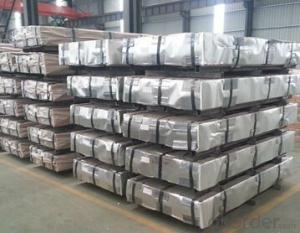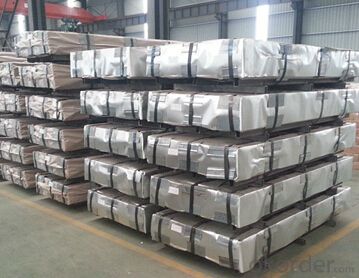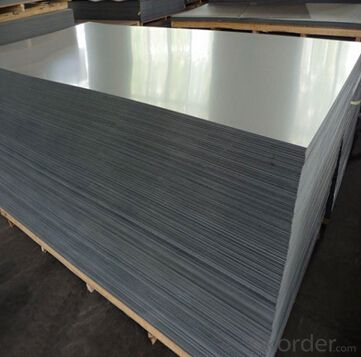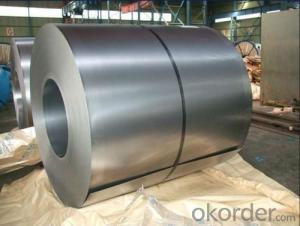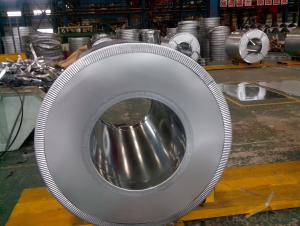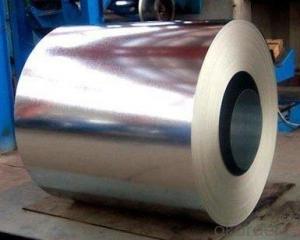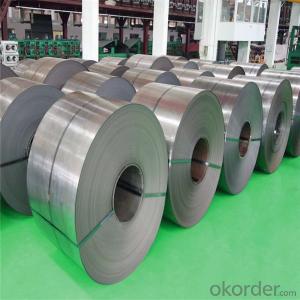Galvanized steel coil Z275 No spangle 0.15mm
- Loading Port:
- Tianjin
- Payment Terms:
- TT OR LC
- Min Order Qty:
- 25 m.t.
- Supply Capability:
- 10000 m.t./month
OKorder Service Pledge
OKorder Financial Service
You Might Also Like
Galvanized Steel Sheet
1.Thickness: 0.15mm - 3.5mm
2.Width: 600mm - 2000mm
3.Length: As you request
Specifications of Hot Dip Galvanized Steel Sheet/Plate:
1) Capacity: about 1,5000 tons per month for the steel sheet and coil product.
2) Grade: SGCC, DX51D, Q195, all according to the customer's request
3) Standard: JIS G3302 1998, ASTM A653M/A924M 2004, all according to the customer's request
4) Thickness: 0.15mm - 3.5mm, all available.
5) Width: 600mm - 2000mm , all available.
6) Length: we can adjust the length according to your request
7) Elongation: Min. 7%
8) Zinc coating weight: Min. 60gm/mm2, double side
9) Tensile strength: 28.1 - 49.2kgf/mm2
10) Spangle: regular spangle, minimized spangle and zero spangle
11) Surface treatment: chemical passivating treatment, oils, passivating oils, Anti-finger print;
12) Edge: mill edge, cut edge
13) Min trial order 25 ton each thickness, 1x20' per delivery;
Surface Finish of Hot Dip Galvanized Steel Sheet/Plate :
| Surface finish | Pattern | Application |
| Regular spangle | Standard spangles with flower pattern | General uses |
| Minimized spanlge | Minimized spangles than regular | General painting applications |
| Zero spangle | Extremely minimized spangles | Special painting applications |
Applications of Hot Dip Galvanized Steel Sheet/Plate:
1. Construction and building: roofings, ventilating duct; handrail; partition panel,etc.
2.Further processing: coating base plate.
3. Electric appliances: refrigerator; washing machine; recorder; microwave, etc.
Features of Hot Dip Galvanized Steel Sheet/Plate :
1) Hot Dip Galvanized Steel Sheet/plate is manufactured to have a long durability, strong corrosion resistance and shiny surface.
2) Hot Dip Galvanized steel features excellent forming properties, paintability, weldability, and is suitable for fabrication by forming, pressing and bending
- Q: What are the different types of coil edge trimming machines?
- There are several different types of coil edge trimming machines available in the market. These machines are specifically designed to trim the edges of coils or rolls of various materials such as metal, paper, plastic, or fabric. Each type of machine has its own unique features and capabilities, catering to different trimming requirements. 1. Manual Edge Trimmers: These machines are operated manually, where an operator manually feeds the coil and trims the edges using a cutting tool or blade. Manual edge trimmers are typically used for low volume trimming applications and require the operator's skill and precision. 2. Semi-automatic Edge Trimmers: These machines have automated feeding mechanisms that assist in feeding the coil through the machine. The trimming process is still performed manually by the operator using a cutting tool, but the feeding mechanism reduces manual effort and increases productivity. 3. Automatic Edge Trimmers: These machines are fully automated and require minimal operator intervention. They are equipped with advanced sensors and controls that enable precise and consistent trimming of coil edges. Automatic edge trimmers can handle high volumes of coils and are often integrated into production lines for continuous trimming operations. 4. Rotary Blade Edge Trimmers: These machines utilize rotary blades to trim the edges of coils. The rotary blades rotate at high speeds, cutting through the material with precision. Rotary blade edge trimmers are commonly used for plastic or fabric coils, as they provide clean and smooth cuts. 5. Guillotine Edge Trimmers: These machines use a guillotine-like cutting mechanism to trim the edges of coils. The cutting blade moves vertically and cuts through the coil material in a straight line. Guillotine edge trimmers are suitable for trimming metal or paper coils, as they provide straight and accurate cuts. 6. Laser Edge Trimmers: These machines use laser technology to trim coil edges. The laser beam precisely cuts through the material, resulting in clean and precise edges. Laser edge trimmers are often used for delicate or high-value materials, as they minimize the risk of damage or distortion. Each type of coil edge trimming machine has its own advantages and limitations, and the choice of machine depends on the specific requirements of the application. Factors such as material type, coil dimensions, trimming precision, and production volume should be considered when selecting the appropriate machine.
- Q: Which is more reactive? Zinc or Steel? And why?
- Zinc. Steel is an alloy consisting mostly out of iron, In the reactivity seris, zinc is more reactive than iron. Therefore, zinc is more reactive than steel
- Q: Can steel coils be welded?
- Yes, steel coils can be welded. Welding is a common method used to join steel coils together or to other steel components, allowing for the formation of strong and durable connections in various applications.
- Q: I'm not really sure if carbon steel is considered a metallic material.
- Steel with a lower to medium level of carbon will typically be reserved for metal sheeting for use in construction, due to its increased hardness and malleability.
- Q: How are steel coils used in the production of steel bolts?
- Steel coils are used in the production of steel bolts as they serve as the primary raw material. The coils are unwound and fed into a machine that cuts and shapes the steel into bolts of the desired size and shape. The coils provide a continuous supply of high-quality steel, ensuring the consistency and strength of the bolts produced.
- Q: What are the different methods of steel coil surface cleaning?
- Some of the different methods of steel coil surface cleaning include pickling, shot blasting, and chemical cleaning. Pickling involves immersing the steel coil in an acid solution to remove oxides and scales. Shot blasting uses high-speed particles to remove rust, scale, and paint from the surface. Chemical cleaning involves using specialty chemicals to dissolve contaminants and restore the steel coil's surface.
- Q: and what type of metal is steel?
- From the steel store. ;) Steel is an alloy consisting mostly of iron, with a carbon content between 0.2% and 2.14% by weight (C:110–10Fe), depending on grade. Carbon is the most cost-effective alloying material for iron, but various other alloying elements are used such as manganese, chromium, vanadium, and tungsten.
- Q: What are the different types of steel coil edge conditions?
- There exist various steel coil edge conditions, each tailored to specific needs and uses. The most prevalent categories are as follows: 1. Mill Edge: The default edge condition for hot-rolled steel coils, wherein the edges remain untouched after the rolling process. This condition is characterized by a slightly rough and uneven surface. 2. Slit Edge: Achieved by cutting the coil across its width to obtain narrower strips. This condition is typically smoother and more uniform than mill edge, making it ideal for applications requiring a clean and precise edge. 3. Trimmed Edge: Achieved by eliminating irregularities and imperfections from the coil's edges. This process yields a straight and smooth edge, suitable for applications necessitating a precise and uniform surface. 4. Deburred Edge: Created by removing burrs or sharp edges from the coil. Commonly used in safety-oriented applications to eliminate potential hazards associated with sharp edges. 5. Round Edge: Attained by rounding the corners of the coil. Often employed in applications requiring easy handling or when preventing damage to other materials or surfaces is crucial. 6. Slit and Deburred Edge: Combines the advantages of both slit and deburred edge conditions. Involves cutting the coil into narrower strips and subsequently removing any burrs or sharp edges, resulting in a clean and safe edge. Each of these edge conditions serves a distinct purpose and is selected based on the specific requirements of the application. By comprehending the various types of steel coil edge conditions, one can choose the most appropriate option to ensure optimal performance and safety.
- Q: What is the role of steel coils in the automotive industry?
- The automotive industry heavily relies on steel coils as the primary raw material for manufacturing various vehicle components. These coils, made from high-quality steel, are shaped into a continuous strip that can be easily processed to create desired automobile parts. One crucial application of steel coils in the automotive industry is their role in producing body panels and frames. Through stamping and forming techniques, these coils are transformed into panels like doors, hoods, fenders, and roofs. Steel coils provide the necessary strength, durability, and rigidity to protect passengers and other vehicle components from external forces. Furthermore, steel coils are also used in manufacturing various structural components of automobiles. Chassis, suspension systems, engine cradles, and brackets are typically produced using steel coils due to their excellent mechanical properties. Their high tensile strength enhances the overall structural integrity of the vehicle, ensuring safety. Additionally, steel coils are integral in producing automotive springs, which are essential for the suspension system. Coil springs, leaf springs, and torsion bars are commonly used to absorb shocks, provide stability, and maintain proper ride height. The utilization of steel coils in these applications guarantees optimal performance, durability, and longevity of the suspension system. In conclusion, the versatility, strength, and durability of steel coils make them vital in the automotive industry. They are utilized in manufacturing body panels, frames, structural components, and suspension systems, contributing to the overall safety, reliability, and performance of vehicles.
Send your message to us
Galvanized steel coil Z275 No spangle 0.15mm
- Loading Port:
- Tianjin
- Payment Terms:
- TT OR LC
- Min Order Qty:
- 25 m.t.
- Supply Capability:
- 10000 m.t./month
OKorder Service Pledge
OKorder Financial Service
Similar products
Hot products
Hot Searches
Related keywords
